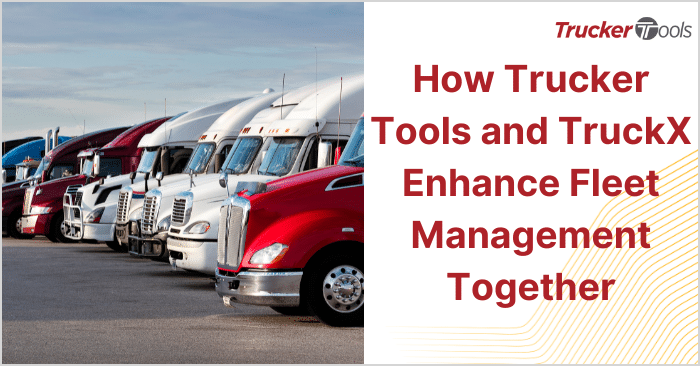In today’s world of freight brokerage and logistics, truck tracking provides you and your customers with real-time visibility of shipments. When you use truck tracking technology on freight loads, you can view the real-time location of shipments while they’re in transit. This real-time tracking data typically increases the level of service you can provide to your shippers, while also providing a host of additional benefits.
What Is Truck Tracking?
Truck tracking and the technology used to track shipments has evolved over the last 10 to 20 years. Until relatively recently, technology-based truck tracking relied upon cell phone tower pings and triangulation technology, which has since been discontinued by cellular providers. The most popular type of truck tracking technology in use today employs the GPS capabilities in the trucker’s smart phone and a mobile app to provide highly accurate digital location updates every five to 15 minutes. Loads also may be digitally tracked using a driver’s electronic logging device (ELD), a congressionally mandated device that tracks driver duty status and automatically records driving time to comply with hours of service regulations.
How Does Truck Tracking Work?
For decades, freight brokers tracked brokered loads with manual phone calls to the trucker transporting the load or to a carrier dispatcher. Within the industry, these calls to check the location of the shipment are often referred to as “check calls.” Today’s digital truck tracking processes use technology to track the real-time location of shipments and to calculate accurate estimated arrival times. When it comes to truck tracking, you have two technology-based options: tracking with a mobile app and/or with the driver’s ELD.
Truck Tracking App
With app-based truck tracking, the driver must download the mobile app to their smart phone. Once the app has been downloaded, the driver will receive a prompt through the app to start using the GPS tech in the smart phone to digitally track the load. After the driver accepts the track, the app will transmit location updates every five to 15 minutes from the driver’s smart phone to the load tracking platform used by you, the broker. Once the driver delivers the load, they can end the track. Some freight brokerages use geofencing to automatically prompt the driver to start the track once they enter the pickup location and to stop the track when they approach the delivery location.
ELD Tracking
In order to offer ELD-based truck tracking to drivers and carriers, your real-time load tracking software platform must be able to be integrated with the ELD used by the driver. Once an ELD provider’s device is integrated with the visibility platform you use, you’ll receive location pings from the driver’s ELD instead of a mobile app. One of the benefits of ELD-based tracking for drivers and carriers is that it’s a one-time integration.
Four Truck Tracking Best Practices
By following these four truck tracking best practices, you can improve your load tracking process and achieve the best results.
1. Offer App and ELD-Based Truck Tracking Options
Offering both app-based and ELD-based truck tracking options to carriers and drivers is a must. Doing so increases the likelihood that carriers and drivers will actively participate in digital load tracking and that you’ll ultimately get the load visibility you and your shippers require.
2. Use a Value-Add Mobile App
To encourage carrier and driver compliance, choose a mobile app that provides true value to drivers and carriers. Instead of opting for an app that solely tracks freight for brokers, make a multi-functional driver app like Trucker Tools’ part of your truck tracking strategy. Using a value-add mobile app will encourage drivers to keep the app on their phones.
3. Release Load Details After Driver Downloads App
Depending on your circumstances and strategy, you may want to withhold load details such as the pickup number or purchase number until the driver has downloaded the truck tracking app and agrees to track the load with the app. This ensures that the driver agrees to tracking before anything else can happen.
4. Encourage Document Upload Upon Delivery
It’s a good idea also to offer document upload capabilities to drivers through the mobile app that you use for truck tracking. Doc upload allows drivers to take photos of bills of lading and proof of delivery documents with their smart phones and send them securely to you via the app in a matter of seconds. Ultimately, this helps drivers and carriers get paid faster, while encouraging them to track.
Truck Tracking Benefits for Freight Brokers and Freight Shippers
Truck tracking via mobile app or ELD provides multiple benefits to freight brokers and freight shippers. For freight brokers like you, real-time truck tracking data empowers you to provide highly accurate ETAs to your customers. With real-time truck tracking technology, you can literally see on your computer screen if a driver has taken a wrong turn, gone to the incorrect pickup location and/or encountered traffic. As such, you can notify shippers of potential delays in real-time and work to rectify delays immediately. Digital truck tracking reduces human errors, increases your productivity by reducing or eliminating check calls, helps you identify double brokering scams, and even can help you locate your shipments if they’re ever lost or stolen.

Real-time truck tracking is essential for freight shippers because it helps them optimize their supply chains for greater efficiency, identify high-performing partners and better manage their internal human resources. Perhaps most importantly, shippers’ distributors and customers expect real-time updates on their deliveries just as we all do in our personal lives. Truck tracking helps shippers meet their own customers’ expectations and provide the highest levels of service.
Learn “What Is Double Brokering and How To Safeguard Against It.”
Schedule a free demo of Trucker Tools’ truck tracking software platform.





